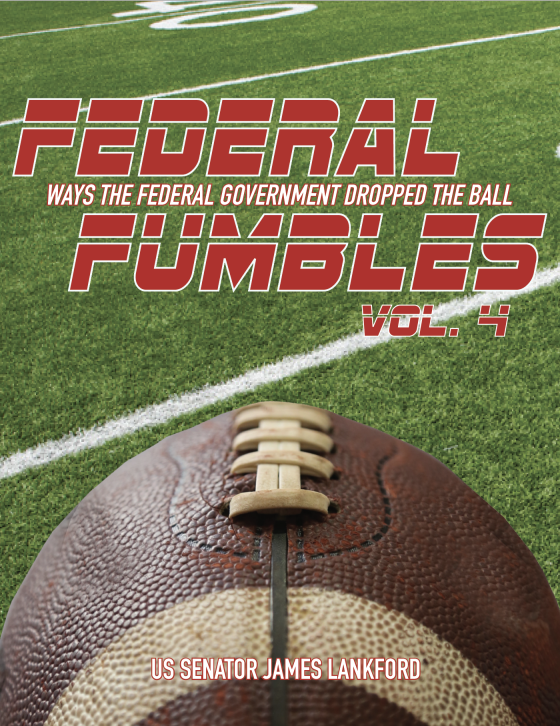The fourth volume of Federal Fumbles: Ways the federal government dropped the ball was released TODAY.
CLICK HERE to read the full report online.
CLICK HERE to watch the video announcement.
CLICK HERE to watch my floor speech.

I view Federal Fumbles as my to-do list for the upcoming year, and my office works to address as many of the entries from previous Fumbles volumes as possible to help actually solve the waste and inefficiency, not just talk about it. This year’s volume focuses heavily on government inefficiency and wastes of time as well as federal tax dollars. The federal government should work for the taxpayers and spend your tax dollars wisely. As I have said many times, Congress cannot fix what it cannot see. This report sheds much-needed daylight on inefficient, ineffective taxpayer-funded programs and provides solutions to those issues. We also highlight the "Touchdowns" and "Forward Progress" that have been made from entries highlighted in previous versions of the report.
Highlights from 2019 Fumbles
1. “Let’s Shut Down the Shutdowns” (Pages 1-2) – The recent longest-ever government shutdown cost taxpayers approximately $11 billion. Last week, Lankford introduced the Prevent Government Shutdowns Act, which would hold Members of Congress, Senators, and the White House accountable for failure to fund the government, instead of our federal families. The bill would require House and Senate members, the White House and Cabinet, and Office of Management and Budget leadership and staff to remain in Washington, DC, until appropriations are restored. The government would remain open with a continuing resolution until the dysfunction in Washington ends. It’s time to stop wasting taxpayers’ time and money on government shutdowns that end up costing us more than keeping the government open.
2. “GREAT Act” (Page 21) – Outdated, duplicative, document-based forms for federal grant reporting make applying for federal tax dollars over-burdensome and over-complicated. In fact, the federal government uses reporting platforms from more than 444 post-award grant forms with no standard data entry. The information is not searchable and requires heavy compliance burdens from grantees. The GREAT Act would help solve that so that taxpayers know where and when their money is spent. Below are a few examples of grants that highlight the need for greater transparency and discretion when spending limited taxpayer dollars:
- “From Russia with Wine” (Page 21) – Russia is known for many things, including corruption, meddling, and vodka. However, a new breakthrough is in the works: a book that studies the Russian wine industry throughout the late eighteenth and early nineteenth centuries. In FY17 the National Endowment for the Humanities (NEH) awarded a $50,400 fellowship to a professor at Sonoma State University. The finished product, Whites and Reds: Wine in the Lands of Tsar and Commissar, examines the ways Russia used its wine industry to befriend Europe during the Russian Empire and the Soviet eras.
- “Mariachi Madness” (Page 22) – In FY18, the National Endowment for the Arts (NEA) awarded $50,000 to the City of San Fernando, CA, for its Mariachi Master Apprentice Program. Moreover, this program has received federal grants totaling a whopping $725,000 since 2001.
- “Crafting Craze” (Page 22) – In FY18, the NEA awarded a $50,000 federal grant to the City of Los Angeles for the PBS series, Craft in America. In fact, since 2005 the NEA has awarded more than $1.7 million to this production.
3. “Can You Hear Me Now from My Tractor?” (Page 23) – Have you ever felt like you have been ripped off? I’m sure rural Americans do if they paid for but did not receive better cell phone and internet service. The High Cost Fund, which will be the Connect America Fund, was originally created as a program through the Universal Service Fund (USF) in 1996 to help build telecommunication infrastructure in poorly connected mostly rural areas. Americans have paid billions into these funds through USF fees on their monthly phone bills, regardless of where they live. In 2017 the USF disbursed a total of $8.8 billion, but the problem persists.
4. “$30 Million: Where’d IT Go?” (Page 40) – Congress authorized $30 million in the Forever GI Bill for necessary IT repair in September 2017, which was supposed to fix problems facing the Muskogee VA regional office and others. After my visit to the Muskogee office, my question is simple: what happened to the $30 million?
5. “This Land (Backlog) is Your Land Backlog” (Page 43) – The federal government controls about 28 percent of all the land in the US, primarily west of the Mississippi, through just four federal agencies: USDA, BLM, FWS, and NPS. While the amount of federally owned land in Oklahoma is minimal, Oklahoma taxpayers are still on the hook for the upkeep of the 640 million acres of land throughout the US. Decades of adding to our federal land holdings have led to a maintenance backlog of $18.6 billion across the four main landholding agencies, which means families’ experiences at these sites will not live up to their full potential.

|
Stay Connected!
If you would like more information on these topics, please do not hesitate to call my DC office at (202) 224-5754. My Oklahoma City office can be reached at (405) 231-4941 and my Tulsa office at (918) 581-7651. You can also follow me on Facebook or Twitter or Instagram for updates on my work in Congress.
Notice: If you wish to stop ALL electronic communications from my office, visit this link to opt out permanently from this list. If you have any questions about this Notice or your right to decline future electronic mail from this office, please contact us at United States Senate, 316 Hart Senate Office Building Washington, DC 20510.
|
|
|